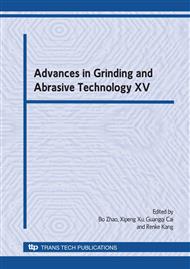p.578
p.583
p.588
p.593
p.598
p.603
p.609
p.614
p.619
Research on the Surface/Subsurface Damages of ZTA Ceramics under Two-Dimensional Ultrasonic Vibration Assisted Grinding
Abstract:
ZTA ceramics is a kind of high performance structural ceramics, and its surface/subsurface damages after machining have great effect on reliability and long-service life of ceramic parts, so it introduces two-dimensional ultrasonic vibration assisted grinding (TUVAG) which is applied in the precision finishing of ZTA ceramic, mathematic motion model of abrasive grain during TUVAG is established, and the special machining path of abrasive grain during TUVAG is analyzed, and the surface/subsurface damages of ZTA ceramics after TUVAG are further discussed. Experimental results prove that TUVAG may make materials removed in a plastic state mostly, the probability of cracks formation and propagation becomes less, and obviously reduce surface damages of ZTA ceramics, and the grinding badness layer of ceramics after TUVAG is shallower than that after diamond grinding at the same grinding parameters.
Info:
Periodical:
Pages:
619-623
Citation:
Online since:
September 2009
Authors:
Keywords:
Price:
Сopyright:
© 2009 Trans Tech Publications Ltd. All Rights Reserved
Share:
Citation:


